“There was a good deal of confusion in men’s minds during the first months of the great trouble, a good deal of unsettledness, of leaning first this way then that, and then the other way. It was hard for us to get our bearings.” -Mark Twain 
If you are of a certain age, you probably remember being herded en masse onto a grade school stage and forced to warble Fifty Nifty United States to beaming moms, dads and grandparents.
“Fifty, nifty, United States, from thirteen original colonies,” the song cheerfully began. Unfortunately, there wasn’t much to it beyond rhyming “fifty” and “nifty.” It eventually meandered through a roll call of the “nifty” states in alphabetical order. Missing from that roster was the Kingdom of Calloway. And the Free State of Winston. And the Free State of Jones.
But each one briefly existed (more or less) during the turbulent time known as the Civil War. And it’s worth revisiting their short, strange stories to fully understand just how mixed-up that era was.
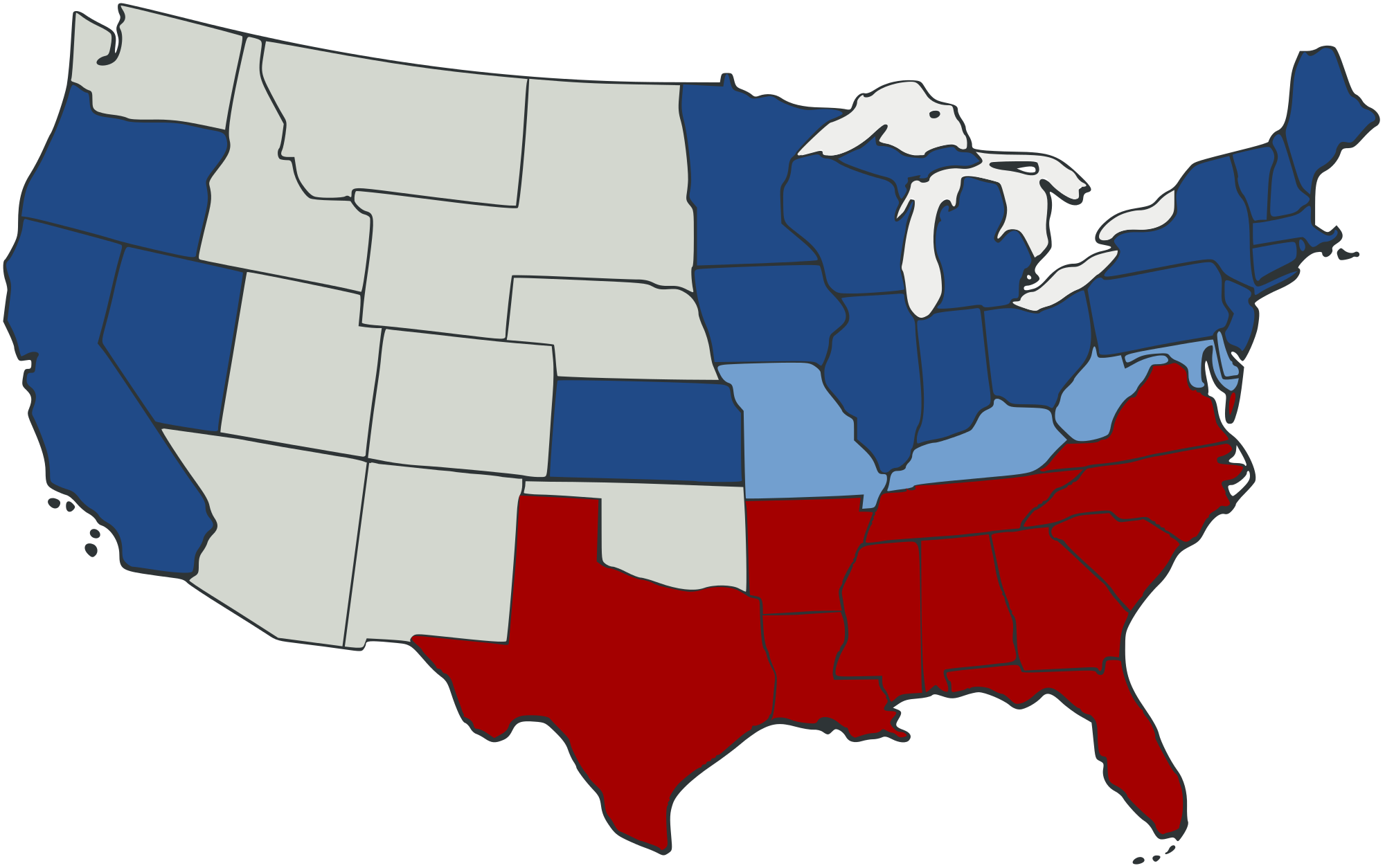 We 21st Century Americans think of the Civil War as a battle between neatly-aligned Northern and Southern states. But the reality was far more complicated.
We 21st Century Americans think of the Civil War as a battle between neatly-aligned Northern and Southern states. But the reality was far more complicated.
It was easy to be all for the Union in New England, or solidly Confederate in the Deep South. But the closer you got to the middle, the murkier things grew. People there were pulled in both directions. Mark Twain summed it up best: “It was hard for us to get our bearings.”
Some folks took it even further. If a state could secede from the Union, they reasoned, a county could secede from a state. Others saw opportunities for local greatness.
Consider the Kingdom of Calloway in Missouri. Its sympathies were staunchly pro-Southern. Callaway County is located in a part of the Show-Me State still referred to as Little Dixie. (How’s this for Missouri orneriness? Little Dixie is in the northeastern part of the state, closer to Illinois and Iowa than it is to Tennessee and Arkansas. Go figure.)
 In October 1861, a lawyer named Jefferson Jones popped up as commander of a little ragtag pro-Confederate band of old men and young boys. (Jones’ colonelcy seemed to pop up out of nowhere, too. There’s no record of him ever been appointed to that rank. But in fairness, a lot of “colonels” on both side sides mysteriously materialized in the war’s early months.)
In October 1861, a lawyer named Jefferson Jones popped up as commander of a little ragtag pro-Confederate band of old men and young boys. (Jones’ colonelcy seemed to pop up out of nowhere, too. There’s no record of him ever been appointed to that rank. But in fairness, a lot of “colonels” on both side sides mysteriously materialized in the war’s early months.)
 Jones got wind that Union General John Henderson was approaching with 600 militiamen. In a bluff that would have made a poker player proud, Jones marched his little group toward the Federals, parading them in a loop to seem larger than they actually were. He also hauled out several “Quaker guns,” logs stripped of bark and painted black so they looked like cannon from afar, and pointed them at the Yankees.
Jones got wind that Union General John Henderson was approaching with 600 militiamen. In a bluff that would have made a poker player proud, Jones marched his little group toward the Federals, parading them in a loop to seem larger than they actually were. He also hauled out several “Quaker guns,” logs stripped of bark and painted black so they looked like cannon from afar, and pointed them at the Yankees.
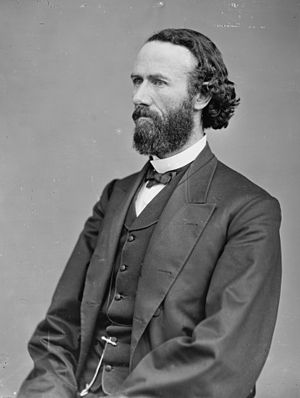 Jones then sent Henderson a letter offering a deal. Henderson must promise to not occupy the county (which he grandly called the Kingdom of Callaway). If he did so, Jones would disperse his “superior forces” and go home. If Henderson refused, Jones would attack and there would be a bloody battle.
Jones then sent Henderson a letter offering a deal. Henderson must promise to not occupy the county (which he grandly called the Kingdom of Callaway). If he did so, Jones would disperse his “superior forces” and go home. If Henderson refused, Jones would attack and there would be a bloody battle.
Apparently believing discretion is the better part of valor, Henderson accepted. He even signed a peace treaty of sorts between Callaway County and the United States of America! And so the matter ended in a Confederate “victory” without a shot being fired. Locals felt the phrase Kingdom of Callaway had a nice ring to it and adopted it as their nickname. They even designed their own flag in 1961 to mark the “Kingdom’s” centennial.
 (Side note: Kingdom or County, Callaway’s neutrality didn’t last long. The real Union army arrived a few months later, laughingly ignoring the “peace treaty” as they seized control of the place. Jones was soon captured and spent the duration of the war stuck in a Saint Louis prison. Not long after the Callaway incident, Henderson was appointed to the U.S. Senate, where presumably he was more helpful to the Union war effort than he had been on the battlefield.)
(Side note: Kingdom or County, Callaway’s neutrality didn’t last long. The real Union army arrived a few months later, laughingly ignoring the “peace treaty” as they seized control of the place. Jones was soon captured and spent the duration of the war stuck in a Saint Louis prison. Not long after the Callaway incident, Henderson was appointed to the U.S. Senate, where presumably he was more helpful to the Union war effort than he had been on the battlefield.)
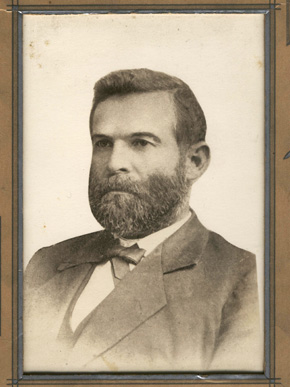 While all this was going on, trouble was brewing in another county 515 miles away in the rugged hills of north Alabama. When that state called a secession convention in January 1861, the people of Winston County elected a 21 year-old school teacher named Charles Sheats as their delegate. He not only voted against Alabama leaving the Union, he refused to sign the ordinance of secession when it passed.
While all this was going on, trouble was brewing in another county 515 miles away in the rugged hills of north Alabama. When that state called a secession convention in January 1861, the people of Winston County elected a 21 year-old school teacher named Charles Sheats as their delegate. He not only voted against Alabama leaving the Union, he refused to sign the ordinance of secession when it passed.
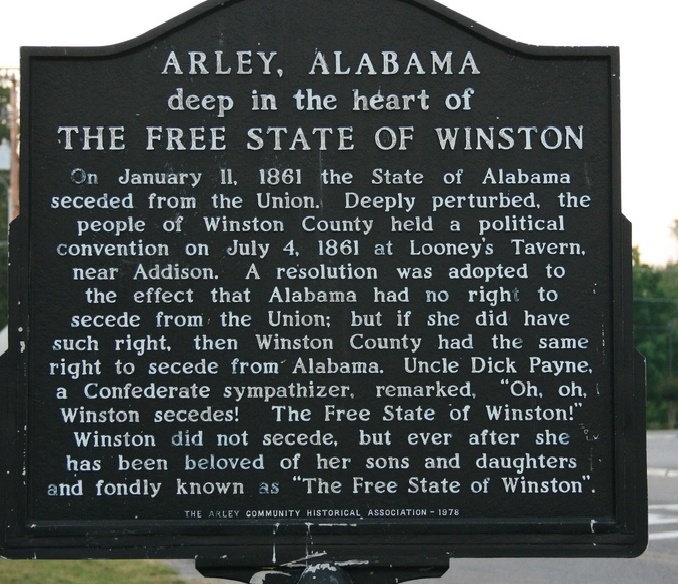 Secession didn’t sit well with Winston County folks. So they held their own convention on July 4, 1861, gathering at Looney’s Tavern (I’m not making that up). They passed a series of resolutions saying they wouldn’t take sides or participate in the war. That made a pro-Confederate lawyer snidely snort, “Winston County secedes, eh? Well, hooray for the Free State of Winston!” The locals took a shine to the name and wore it as badge of honor.
Secession didn’t sit well with Winston County folks. So they held their own convention on July 4, 1861, gathering at Looney’s Tavern (I’m not making that up). They passed a series of resolutions saying they wouldn’t take sides or participate in the war. That made a pro-Confederate lawyer snidely snort, “Winston County secedes, eh? Well, hooray for the Free State of Winston!” The locals took a shine to the name and wore it as badge of honor.
(Side note: Young Mister Sheats was also elected state representative in 1861. But his pro-Union views didn’t sit well in the state capital. He was kicked out of the legislature the next year, and was briefly imprisoned for treason, though he never stood trial. He became a lawyer after the war, served as U. S. consul to Denmark for a while, and was even elected to one term in Congress in 1872. So things worked out well for Sheats.)
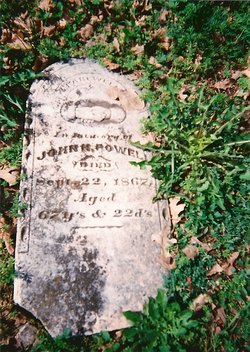 Finally, a similar story unfolded in nearby Jones County, Mississippi. When picking its delegate to their state’s secession convention in January 1861, residents overwhelmingly elected anti-secessionist John Hathorne Powell, Jr. (No relation.) He voted against Mississippi leaving the Union, and was supposedly burned in effigy at the county seat for it.
Finally, a similar story unfolded in nearby Jones County, Mississippi. When picking its delegate to their state’s secession convention in January 1861, residents overwhelmingly elected anti-secessionist John Hathorne Powell, Jr. (No relation.) He voted against Mississippi leaving the Union, and was supposedly burned in effigy at the county seat for it.
Jones and neighboring Covington Counties were flooded with deserters from the Confederate Army, who found a warm welcome among Unionist locals there. The area descended into lawlessness, and old scores were settled with guns. A band of ex-Confederate soldiers was led by a guy named Newt Knight, who tried to adopt a kind of Robin Hood persona, protecting simple, plain folk from oppressive Confederate authorities. The gang fought at least 14 skirmishes with Confederate troops.
Chaos followed. By spring 1864, the U.S. flag was flying over Winston’s courthouse. That July, a Natchez newspaper reported Jones County had seceded from Mississippi (and the Confederacy, too). It was a savage, nasty, bitter situation, with deep undercurrents of racial prejudice playing out as well.
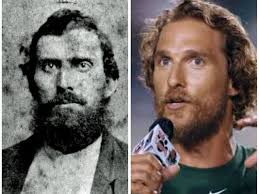 A major motion picture called The Free State of Jones is scheduled to hit theaters this summer, with actor Matthew McConaughey playing Newt Knight. The two bear a resemblance to one another. But given Hollywood’s dismal track record for historical inaccuracy, I’m not holding my breath that the movie will bear much resemblance to what actually happened.
A major motion picture called The Free State of Jones is scheduled to hit theaters this summer, with actor Matthew McConaughey playing Newt Knight. The two bear a resemblance to one another. But given Hollywood’s dismal track record for historical inaccuracy, I’m not holding my breath that the movie will bear much resemblance to what actually happened.
They’re lost in the mist of time now, these three little rump entities. You have to rummage deep in history’s toy box to even find mention of them.
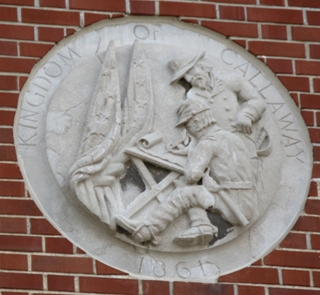 The Kingdom of Callaway. The Free State of Winston. The Free State of Jones. Sad legacies of the time when Americans completely lost the ability to peacefully resolve their differences.
The Kingdom of Callaway. The Free State of Winston. The Free State of Jones. Sad legacies of the time when Americans completely lost the ability to peacefully resolve their differences.
Did you find this enjoyable or helpful? Please continue to join me each week, and I invite you to read Tell it Like Tupper and share your review!
Curious about Tell It Like Tupper? Here’s a chance to see for yourself. Take a sneak peek at a couple chapters in this free downloadable excerpt.
